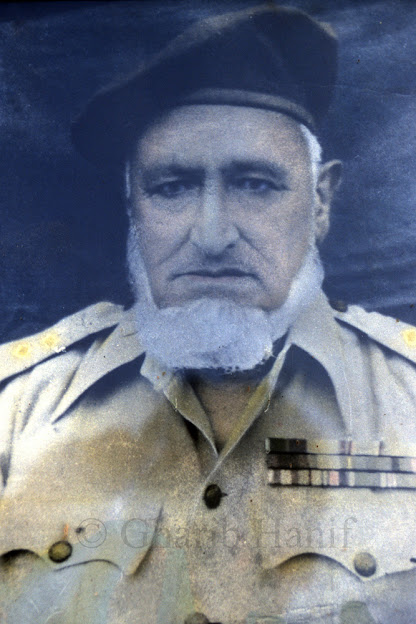Hast-o-Bood Part-42
Chapter 7
Arrival and residence of Rajput Mangral in Gujarat
In addition to fulfilling his position, he was engaged in public service. The government and the people were equally impressed by his sincerity and high character. His understanding of the matter and the government's confidence in him can be gauged from the decree issued by Sardar Gulab Singh Dogra, the commander-in-chief, in his name on 13 August 1888, in which he was given ammunition in his possession Weight and quantity were discovered. They were also questioned about the estimated quantity of useless and useful ammunition and the quantity of modern ammunition that had to be kept in the fort.
Mian Rasool Bakhsh was also given a few houses adjoining the fort of Gujarat by the order and order of the Maharaja where he and his other family members resided. Thus they permanently returned to their original place of migration. Mian Muhammad Azam's youngest son, Mian Noro Khan, meanwhile, had chosen a different arena for himself in view of the Maharaja's passion for horsemanship. He learned the mysteries and secrets of Shahsawari from the elders of the famous Chabakswar family of Lahore and worked hard to become an expert in equestrianism. His passion was motivated by Maharaja Ranjit Singh and his Crown Prince Kharak Singh's fondness for high breed horses and appreciation of the royal cavalry. At that time, the royal stables of Lahore were unique and famous in the subcontinent. Maharaja Ranjit Singh used to procure good breed horses from his conquered lands and was notorious for his selfishness in seizing such animals at any cost. Which can be confirmed by the following incidents.
In April 1806, Maharaja Ranjit Singh [1] marched there with Lashkar-e-Jarrar for the conquest of Multan. Therefore, Nawab Muzaffar Khan, the ruler of Multan, closed the fort. The Sikh army also laid siege to the fort. To get rid of this catastrophe, Nawab Muzaffar Khan made peace and proceeded to pay homage to the preacher with Rs. 80,000 in cash and five high-bred horses. The Maharaja's eyes fell on his beautiful horse and his companions with great foresight ordered the landlord to present his animal to the Maharaja. The landlord became angry at this and he brandished his sword and struck the Maharaja's hand with a sharp slant. Seeing this situation, the Sikh warriors surrounded the landlord, severely wounded him and shot him dead, thus seizing his high breed horse.
In April 1820, Maharaja Ranjit Singh, on his return from a military coup in the state of Jammu and Kashmir, forcibly acquired the beautiful white horse "White Fairy" of Nawab Hafeez Ahmad Khan of Mansehra to adorn his royal stables.
Maharaja Ranjit Singh's passion for horses was such a weakness that even the British rulers of the time were well aware of it. So when in 1828, as a friend, the Maharaja sent a tent of pre-priced shawl to the King of Britain through Lord Emerson as a gift, in response the King of Britain sent Maharaja Ranjit Singh in a dozen carriages at the hands of his envoy Lieutenant Berner. Horses, four high-bred horses, and an excellent horse for genocide [Stalin] were sent to Lahore by boat in 1830 on the Ravi River. After this exchange of gifts, Maharaja Ranjit Singh called on Sir John Malcolm, Governor General of British India, at Ropar on 26 October 1831 to renew the relationship. As a result, the aforesaid Governor-General presented to Maharaja Ranjit Singh a nine-pound cannon which was drawn from horses, along with his horses, which the Maharaja gladly accepted.
Maharaja Ranjit Singh's passion for horse breeding and raising good animals was free from the disrespect of the sentiments and slogans of other religions. So, completely ignoring the Islamic slogan, he turned the famous Alam Shahi Mosque in Lahore into his horse stable. And thus the house of God continued to injure the hearts of the Muslim subjects. He carried a golden saddle and a simple swing on his special horses. He himself was a high-class rider and valued his riders. He was a handsome and handsome young man, regardless of his religion or nationality.
These were the evidences and motivations that prompted Mian Noro Khan to make a name for himself in Shahsawari. So he surpassed all the courtiers of his time. Maharaja Ranjit Singh appointed him a royal whip in return for his excellence. And the preacher set a monthly subsistence of fifty [2] rupees. Later, in the year 1830, by royal decree, in return for his services to Jalila, he was given 47 acres, two roads, 11 pools of land in Mouza Banth Tehsil and District Gujrat, about one and a half miles away from the city.
After Maharaja Ranjit Singh in 1839, his successor, Kanwar Kharak Singh, became the emperor, but the British war on Gujarat in 1846 also left the Sikhs in ineffective control. Because in those days Sikh centralism was in decline. Even during his reign, the two brothers Mian Rasool Bakhsh Kardar Barood Khana and Mian Noro Khan Shahi Chabakswar were still revered. By decree, Maharaja Kharak Singh restored the previously blessed lands of Mian Noor Khan in the fourth month of Katak 1888 Bk [1843].
[1] ... Punjab Series Volume II The rise of Sikhs in Punjab by Mr. Henry T. Prince
[2] Entry Like No. 61 Under Mode 5 Under Mode II Finance Land Office Mall District Gujarat



Comments
Post a Comment